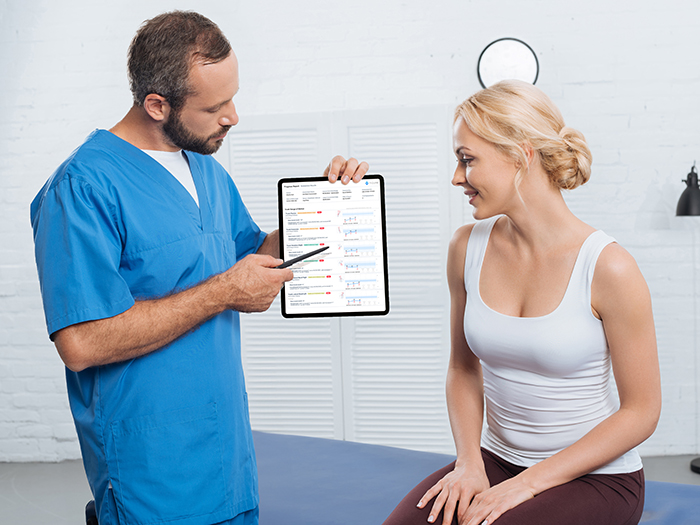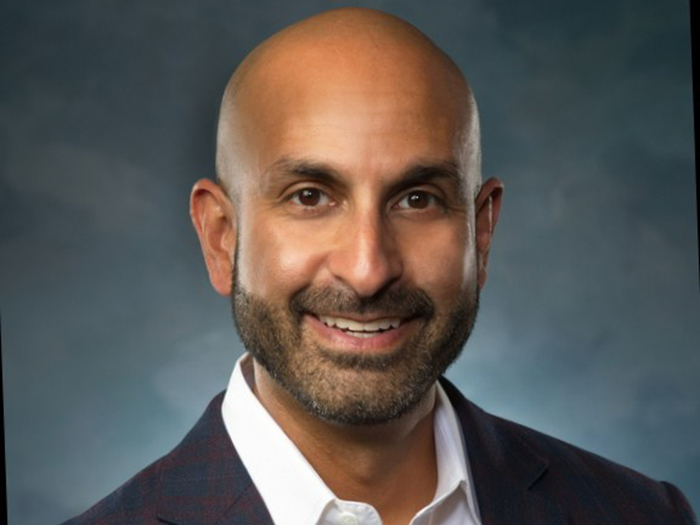Sponsored Content by FIGUR8
How Digital MSK Biomarkers Can Improve Injury Recovery Outcomes

Medical technologies may have come a long way in recent decades, but the process of treating musculoskeletal injuries hasn’t changed much aside from the operating room and the use of biologics.
Orthopedists, physical therapists and other MSK health care providers are likely to take a conservative approach to care, avoiding surgery whenever possible. If you walk into a PT’s office, you might see goniometers and other dated tools being used to measure a patient’s range of motion. Others may rely on patient-reported outcomes (PROs) rather than more objective, data-driven measures for analyzing patient recovery.
Even basic technologies like telemedicine — which became a staple during the pandemic — have “very low utilization in orthopedics, in musculoskeletal care,” said Dr. Michael Oberlander, chief medical officer for FIGUR8. “Orthopedic surgeons have generally not been holistically incorporating this technology into patient care.”
While orthopedic surgeons have been slow to adopt new digital tools, patients are demanding it. Virtual appointments became commonplace during COVID. Patients love their convenience, especially for check-in appointments during an ongoing recovery process.
“The general public was introduced to digital health, and they saw the ability of health care providers to evaluate and treat patients without seeing them in person. It can save significant time, money and hassles associated with routine follow-up care,” Oberlander said.
Orthopedists may be slow to adopt new in-office technologies, but if they evaluated real data analytics from their practice, most would quickly realize that these advances can clearly make their practices more patient-centric and efficient, improving patient outcomes. In workers’ comp, where MSK injuries are both common and costly, digital tools can help doctors effectively track recovery progress, informing a more patient-centric treatment plan and return-to-work capabilities while enabling more rapid recovery.
Sensor technologies like FIGUR8’s bioMotion Assessment Platform (bMAP) are helping providers measure objective recovery metrics — like a patient’s dynamic and functional range of motion and muscle function — which in turn helps adjusters track a claimant’s progress, improve utilization review requests, assist in recommendations for return to work and inform employers if recovery is delayed.
Embracing Technology in MSK Treatment

Dr. Michael Oberlander, Chief Medical Officer, FIGUR8
Health care providers treating musculoskeletal disorders will need to embrace technology in the coming years due to a confluence of factors. By 2025, there’s likely to be a shortage of 5,080 orthopedic surgeons, and in 2021, 22,032 physical therapists left the field, adding to the shortage of health care providers treating musculoskeletal conditions.
At the same time, America’s workforce is aging. Between 2000 and 2020, the number of Americans over 60 in the workforce doubled. This age group is particularly vulnerable to musculoskeletal injuries, as people over 65 account for nearly a quarter of MSKs.
All of this adds up to more patients and fewer doctors available to see them: “Doctors are pressed to see more patients in less time, which means you really don’t have a sufficient amount of time with every patient to sit down and have them understand exactly what’s going on with their condition,” Oberlander said.
Digital tools can address these issues by allowing providers to connect with patients virtually. Educational videos, HIPAA-compliant messaging and telehealth services, remote PT and other tools can all help health care professionals manage musculoskeletal cases by increasing the opportunities for connection and reducing the amount of in-person appointment time needed per claim.
Doctors like these tools because they give patients a variety of ways to engage with their recovery. Patients like them because they reduce the number of in-person checkup appointments they need to attend. Digital tools are also increasing the quality and standardization of recovery data available to providers and adjusters, allowing them to better track and expedite an injured worker’s recovery.
Better Data, Better Recovery
One major way technology is supporting musculoskeletal treatment and recovery is through MSK health biomarker measurement tools. These tools track muscle function, dynamic range of motion and other physical and functional measures of an MSK patient’s recovery, delivering treating providers with validated objective data that can be used to evaluate and adjust treatment plans in a more precise and directed manner.
“We can only analyze so much with our eyeballs. The information gleaned from FIGUR8’s bMAP collects millions of data points in that same period of time,” Oberlander said. “We can now evaluate multiple joints dynamically and simultaneously in the office with minimal cost.”
In workers’ comp, these tools can be used by adjusters and claims managers to determine whether an injured worker is on track to fully heal within the expected time frame. If recovery is lagging or seems abnormal, they can intervene to help get the injured worker back on track.
“We can now determine if a patient is following the normal trajectory,” Oberlander said. “You can actually evaluate hard data on bilateral multi-joint range of motion, quality and consistency of motion and quantitative muscle function, simultaneously and consistently regardless of who is performing the assessment.”
Employers that use FIGUR8’s bMAP to evaluate workers in pre-employment screening or with yearly MSK evaluations can likely prevent many injuries. This same data can also serve to establish a baseline for every employee in the event that an injury does occur.
“If you have somebody who comes in with an established baseline musculoskeletal health exam previously performed with this type of technology, that’s amazingly beneficial,” Oberlander said. “As a treating physician, my job is to get that injured worker back to their previous, uninjured state. Now, I’m not trying to get them back to what is considered normative data for joint or muscle function; I’m trying to get them back to their own baseline. This is a game changer for the patient, provider, employer and insurer.”
Treating Every Injured Worker Like a Professional Athlete
FIGUR8 is a pioneer in using technology to aid in the treatment of musculoskeletal injuries. The company began as a partnership between MIT scientists, Massachusetts General Hospital orthopedic researchers and the Boston Red Sox, aiming to help diagnose and treat athletic injuries. Founder Nan-Wei Gong looked at the work they were doing and thought, Why can’t everyone recovering from an MSK injury access this level of data-driven care?
FIGUR8’s bioMotion Assessment Platform helps ordinary injured workers get the same kind of care as major-league athletes. “We’re trying to augment care; we’re not trying to displace or disrupt care,” Oberlander explained. A highly portable and scalable MSK biomarker measuring tool gives providers more actionable, high-accuracy longitudinal data to evaluate so they can create truly individualized recovery plans for their patients.
In the event that conservative treatments like PT, injections, medication and time don’t result in ideal recovery, these tools can also provide important information for surgeons and rehabilitation professionals to use in helping determine surgical readiness or whether certain patients are even candidates for certain surgical procedures.
“With this technology, I can more definitively evaluate what’s going on with muscle recovery after an injury or surgery. This is essential for decisions related to return to work, sport or even activities of daily living,” Oberlander said.
“Does this patient actually need additional physical therapy or an MRI? What is the probability that the additional treatment or ancillary test is going to alter the trajectory of recovery, affect the likelihood of reinjury or ultimately change that patient’s outcome? Is the patient still demonstrating improvement, have they regressed or have they plateaued?” Oberlander added.
“These are essential questions which can be more quantitatively and qualitatively answered with the use of this technology. It will most definitely change how we practice medicine in the years to come. We are just in the infancy of this technological revolution in precision patient care.”
To learn more, visit: https://figur8tech.com/.
![]()
This article was produced by the R&I Brand Studio, a unit of the advertising department of Risk & Insurance, in collaboration with FIGUR8. The editorial staff of Risk & Insurance had no role in its preparation.










